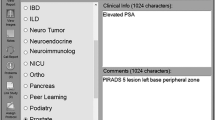Purpose
To develop a personal computer (PC)-based software package that allows portability of the electronic imaging record. To create custom software that enhances the transfer of images in two fashions. Firstly, to an end user, whether physician or patient, provide a browser capable of viewing digital images on a conventional personal computer. Second, to provide the ability to transfer the archived Digital Imaging and Communications in Medicine (DICOM) images to other institutional picture archiving and communications systems (PACS) through a transfer engine.Method/materials: Radiologic studies are provided on a CD-ROM. This CD-ROM contains a copy of the browser to view images, a DICOM-based engine to transfer images to the receiving institutional PACS, and copies of all pertinent imaging studies for the particular patient. The host computer system in an Intel based Pentium 90 MHz PC with Microsoft Windows 95 software (Microsoft Inc, Seattle, WA). The system has 48 MB of random access memory, a 3.0 GB hard disk, and a Smart and Friendly CD-R 2006 CD-ROM recorder (Smart and Friendly Inc, Chatsworth, CA).Results: Each CD-ROM disc can hold 640 MB of data. In our experience, this houses anywhere from, based on Table 1, 12 to 30 computed tomography (CT) examinations, 24 to 80 magnetic resonance (MR) examinations, 60 to 128 ultrasound examinations, 32 to 64 computed radiographic examinations, 80 digitized x-rays, or five digitized mammography examinations. We have been able to successfully transfer DICOM images from one DICOM-based PACS to another DICOM-based PACS. This is accomplished by inserting the created CD-ROM onto a CD drive attached to the receiving PACS and running the transfer engine application.Conclusions: Providing copies of radiologic studies performed to the patient is a necessity in every radiology department. Conventionally, film libraries have provided copies to the patient generating issues of cost of loss of film, as well as mailing costs. This software package saves costs and loss of studies, as well as improving patient care by enabling the patient to maintain an archive of their electronic imaging record.
Similar content being viewed by others
References
Kunjdel HL, Seshadri SB, Arenson RL: Clinical experience with PACS at the University of Pennsylvania. Comput Med Imag Graphics 15:197–200, 1991
Mosser H, Urban M, Hruby W: Filmless digital radiology — Feasibility and 20 month experience in clinical routine. Med Inform 19:149–159, 1994
Osteaux M, Van den Broeck R, Verhelle F: Picture archiving and communications system (PACS): A progressive approach with small systems. Eur J Radiol 22:166–174, 1996
Author information
Authors and Affiliations
Rights and permissions
About this article
Cite this article
Mehta, A., Dreyer, K. & Thrall, J. Enhancing availability of the electronic image record for patients and caregivers during follow-up care. J Digit Imaging 12 (Suppl 1), 78–80 (1999). https://doi.org/10.1007/BF03168762
Issue Date:
DOI: https://doi.org/10.1007/BF03168762




